Thematic Evolution of China’s Media Governance Policies: A Tri-Logic Synergistic Perspective
Abstract
1. Introduction
2. Literature Review
3. Methodology
- (1)
- Scalability and Flexibility: It efficiently processes large-scale text datasets across domains (e.g., legislative documents, social media) and adapts to heterogeneous data formats [38].
- (2)
- Unsupervised Pattern Discovery: In contrast to supervised approaches that necessitate labeled training data, this method autonomously identifies emerging themes and reduces researcher bias in theme predetermination [39].
- (3)
- Visualization and Interpretable Presentation: Its probabilistic topic-word distributions enable intuitive and straightforward interpretation, thereby facilitating interdisciplinary communication and debate between computational and qualitative researchers in social science fields [40].
3.1. Data
3.2. Processing
4. Results
4.1. Temporal Segmentation and Topic Number Selection
4.2. Tri-Logical Analysis of Evolution Across Periods
4.2.1. 1996–2005 Period: Institutionalization of Media Governance Framework Under Emerging Information Society
4.2.2. 2006–2013 Period: Transitioning to Professionalized and Market-Responsive Media Governance
4.2.3. 2014–2020 Period: Technological Empowerment and Legal Governance in the Media Convergence Era
4.2.4. 2021–2024 Period: Precision Governance and People-Centric Service Integration in the AI-Driven Media Era
4.2.5. Integrating Tri-Logic Synergy Across Periods: The Evolutionary Logic of Media Governance Policies
4.3. Co-Word Network Analysis
5. Conclusions, Limitations and Future Research
- (1)
- Technological progress has been foundational, evolving from early distribution authorization protocols to AI-powered response architectures.
- (2)
- Societal priorities have driven policy adjustments, shifting from fundamental public service coordination to more nuanced solutions for complex quality-of-life issues.
- (3)
- Governance paradigms have transitioned from centralized administrative frameworks to integrated systems that prioritize citizen welfare and social cohesion.
- (1)
- Technological Drivers: From Infrastructure Building to Intelligent Precision Governance
- (2)
- Societal Demands: From Stability Primacy to Emotional Resonance
- (3)
- Governance Philosophy: From Institutionalized and Professionalized Governance to Collaborative Governance
Author Contributions
Funding
Data Availability Statement
Conflicts of Interest
References
- Girard, C. Making democratic contestation possible: Public deliberation and mass media regulation. Policy Stud. 2015, 36, 283–297. [Google Scholar] [CrossRef]
- Kassem, N. Which civil society? State-run media and shaping the politics of NGOs in post-uprising Egypt. Policy Stud. 2025, 46, 1–23. [Google Scholar] [CrossRef]
- Jakobsson, P.; Lindell, J.; Stiernstedt, F. Media policy attitudes and political attitudes: The politization of media policy and the support for the ‘media welfare state. Int. J. Cult. Policy 2022, 29, 431–448. [Google Scholar] [CrossRef]
- Liu, W.; James, T.S.; Man, C. Governance and public administration in China. Policy Stud. 2022, 43, 387–402. [Google Scholar] [CrossRef]
- Sun, W. Slow boat from China: Public discourses behind the ‘going global’ media policy. Int. J. Cult. Policy 2015, 21, 400–418. [Google Scholar] [CrossRef]
- Martin, F.; Iwabuchi, K.; Gassin, G.; Seto, W. Transcultural media practices fostering cosmopolitan ethos in a digital age: Engagements with East Asian media in Australia. Inter-Asia Cult. Stud. 2020, 21, 2–19. [Google Scholar] [CrossRef]
- Yang, C.; Huang, C. Exploring the diversity and consistency of China’s information technology policy. J. Inf. Sci. 2024, 50, 1605–1628. [Google Scholar] [CrossRef]
- Liu, X.; Xue, C.; Xie, F. The impact of policy mix characteristics of multi-level governance on innovation output of the new energy vehicle industry in China. Technol. Anal. Strateg. Manag. 2024, 1–14. [Google Scholar] [CrossRef]
- Boossabong, P.; Chamchong, P. The practice of deliberative policy analysis in the context of political and cultural challenges: Lessons from Thailand. Policy Stud. 2019, 40, 476–491. [Google Scholar] [CrossRef]
- Mu, R.; Li, Y.; Cui, T. Policy narrative, policy understanding and policy support intention: A survey experiment on energy conservation. Policy Stud. 2022, 43, 1361–1381. [Google Scholar] [CrossRef]
- Ma, D.; Lv, B.; Li, X.; Li, X.; Liu, S. Heterogeneous Impacts of Policy Sentiment with Different Themes on Real Estate Market: Evidence from China. Sustainability 2023, 15, 1690. [Google Scholar] [CrossRef]
- Bajomi-Lazar, P. Particularistic and Universalistic Media Policies: Inequalities in the Media in Hungary. Javnost 2017, 24, 162–172. [Google Scholar] [CrossRef]
- Banghart, S.; Etter, M.; Stohl, C. Organizational Boundary Regulation Through Social Media Policies. Manag. Commun. Q. 2018, 32, 337–373. [Google Scholar] [CrossRef]
- Thuraisingham, B.; Thomas, T. Social Media Governance and Fake News Detection Integrated with Artificial Intelligence Governance. In Proceedings of the 2024 IEEE International Conference on Information Reuse and Integration for Data Science (IRI), San Jose, CA, USA, 7–9 August 2024; pp. 190–197. [Google Scholar] [CrossRef]
- Antoniazzi, L.; Bengesser, C.H. Media-political inroads for Europeanising national cultural public spheres: EU-level obstacles and national public service perspectives. Int. J. Cult. Policy 2022, 29, 360–376. [Google Scholar] [CrossRef]
- Barr, K. ‘Are you being served?’ Public service media: Audience conceptions of value in UK critical media infrastructure. Int. J. Cult. Policy 2025, 1–17. [Google Scholar] [CrossRef]
- Griffin, R. Public and Private Power in Social Media Governance: Multistakeholderism, the Rule of Law and Democratic Accountability. Transnatl. Leg. Theory 2023, 14, 46–89. [Google Scholar] [CrossRef]
- Bosch, T.; Roberts, T. (Eds.) Digital Citizenship in Africa: Technologies of Agency and Repression, 1st ed.; Zed Books: London, UK, 2023. [Google Scholar] [CrossRef]
- Steemers, J. Blurred Lines: Public Service Media and the State. In Global Media and National Policies; Flew, T., Iosifidis, P., Steemers, J., Eds.; Palgrave Global Media Policy and Business: London, UK, 2016. [Google Scholar] [CrossRef]
- Hallin, D.C.; Mancini, P. Comparing Media Systems: Three Models of Media and Politics; Cambridge University Press: Cambridge, UK, 2004. [Google Scholar]
- Lipset, S. Martin. Political Man: The Social Bases of Politics, 1st ed.; Doubleday: Garden City, NY, USA, 1960. [Google Scholar]
- Beetham, D. The Normative Structure of Legitimacy. In The Legitimation of Power. Issues in Political Theory; Palgrave: London, UK, 1991. [Google Scholar] [CrossRef]
- Shao, G.S.; Lu, J.Y.; Hao, Y. Assessing China’s Media Reform. Asian Perspect. 2016, 40, 27–50. [Google Scholar] [CrossRef]
- Weiguang, W. The Rationale of China’s Media Regulation Policy in the Process of the Institutional Transformation. Notre Dame J. Int. Comp. Law 2017, 7, 64–114. [Google Scholar]
- Kokas, A. Serious chemistry on set: The molecular structure of film investment in China. Int. J. Cult. Policy 2019, 26, 446–458. [Google Scholar] [CrossRef]
- Keane, M. China’s digital media industries and the challenge of overseas markets. J. Chin. Cine. 2019, 13, 244–256. [Google Scholar] [CrossRef]
- MacKinnon, R. China’s “Networked Authoritarianism”. J. Democr. 2011, 22, 32–46. [Google Scholar] [CrossRef]
- Enli, G.; Raats, T.; Syvertsen, T.; Donders, K. Media policy for private media in the age of digital platforms. Eur. J. Commun. 2019, 34, 395–409. [Google Scholar] [CrossRef]
- Muls, J.; Thomas, V.; De Backer, F.; Zhu, C.; Lombaerts, K. Identifying the Nature of Social Media Policies in High Schools. Educ. Inf. Technol. 2022, 25, 281–305. [Google Scholar] [CrossRef]
- Sun, W.; Hu, S.; Shen, L. Quantitative Text Analysis of Circular Economy Policies for Electric Vehicle Batteries in China: Focus on Objectives and Tools. J. Clean. Prod. 2025, 501, 145021. [Google Scholar] [CrossRef]
- Ma, W.; Wang, W. Evolution of renewable energy laws and policies in China. Heliyon 2024, 10, e29712. [Google Scholar] [CrossRef]
- Zhu, M.; Tanaka, K.; Akamatsu, T. Visualizing the annual transition of ocean policy in Japan using text mining. Mar. Policy 2023, 155, 105754. [Google Scholar] [CrossRef]
- Meng, Q.; Fan, Z. Punctuations and diversity: Exploring dynamics of attention allocation in China’s E-government agenda. Policy Stud. 2022, 43, 502–521. [Google Scholar] [CrossRef]
- Clark, S.D.; Lomax, N. Using e-petition data to quantify public concerns during the COVID-19 pandemic: A case study of England. Policy Stud. 2024, 45, 159–182. [Google Scholar] [CrossRef]
- Vayansky, I.; Kumar, S.A.P. A review of topic modeling methods. Inf. Syst. 2020, 94, 101582. [Google Scholar] [CrossRef]
- Zhang, J.; Gui, W.; Wen, J. China’s policy similarity evaluation using LDA model: An experimental analysis in Hebei province. J. Inf. Sci. 2024, 50, 515–530. [Google Scholar] [CrossRef]
- Blei, D.M.; Ng, A.Y.; Michale, I.J. Latent Dirichlet Allocation. J. Mach. Learn. Res. 2003, 3, 993–1022. [Google Scholar] [CrossRef]
- Griffiths, T.L.; Steyvers, M. Finding scientific topics. Proc. Natl. Acad. Sci. USA 2004, 101 (Suppl. 1), 5228–5235. [Google Scholar] [CrossRef] [PubMed]
- DiMaggio, P.; Nag, M.; Blei, D. Exploiting affinities between topic modeling and the sociological perspective on culture: Application to newspaper coverage of U.S. government arts funding. Poetics 2013, 41, 570–606. [Google Scholar] [CrossRef]
- Chaney, A.; Blei, D. Visualizing Topic Models. Proc. Int. AAAI Conf. Web Soc. Media 2021, 6, 419–422. [Google Scholar] [CrossRef]
- Tian, C.; Zhang, J.; Liu, D.; Wang, Q.; Lin, S. Technological topic analysis of standard-essential patents based on the improved Latent Dirichlet Allocation (LDA) model. Technol. Anal. Strateg. Manag. 2022, 36, 2084–2099. [Google Scholar] [CrossRef]
- Lin, L.; Chen, Y. Evolution of Chinese original-innovation talent policies: A topic modelling approach. Technol. Anal. Strateg. Manag. 2023, 36, 4128–4143. [Google Scholar] [CrossRef]
- Yu, X.; He, Y.; Fu, Y.; Xin, Y.; Du, J.; Ni, W. Cross-Domain Developer Recommendation Algorithm Based on Feature Matching. In Computer Supported Cooperative Work and Social Computing Chinese (CSCW 2019), Communications in Computer and Information Science; Sun, Y., Lu, T., Yu, Z., Fan, H., Gao, L., Eds.; Springer: Singapore, 2019; Volume 1042. [Google Scholar] [CrossRef]
- Röder, M.; Both, A.; Hinneburg, A. Exploring the Space of Topic Coherence Measures. In Proceedings of the 8th ACM International Conference on Web Search and Data Mining, WSDM ’15, Shanghai, China, 2–6 February 2015; ACM: New York, NY, USA, 2015; pp. 399–408. [Google Scholar] [CrossRef]
- Feng, Y.; Hou, B.; Klein, A.; O’Connor, K.; Chen, J.; Mondragón, A.; Yang, S.; Gonzalez, H.G.; Shen, L. Exploring Semantic Topics in Dementia Caregiver Tweets. Alzheimer’s Dement. J. Alzheimer’s Assoc. 2024, 20, 1–4. [Google Scholar] [CrossRef]
- Contiero, B.; Holand, Ø.; Cozzi, G. Identifying the optimal number of topics in text mining: A case study on reindeer pastoralism literature. Ital. J. Anim. Sci. 2024, 23, 1348–1357. [Google Scholar] [CrossRef]
- Zimmermann, J.; Champagne, L.E.; Dickens, J.M.; Hazen, B.T. Approaches to improve preprocessing for Latent Dirichlet Allocation topic modeling. Decis. Support Syst. 2024, 185, 114310. [Google Scholar] [CrossRef]
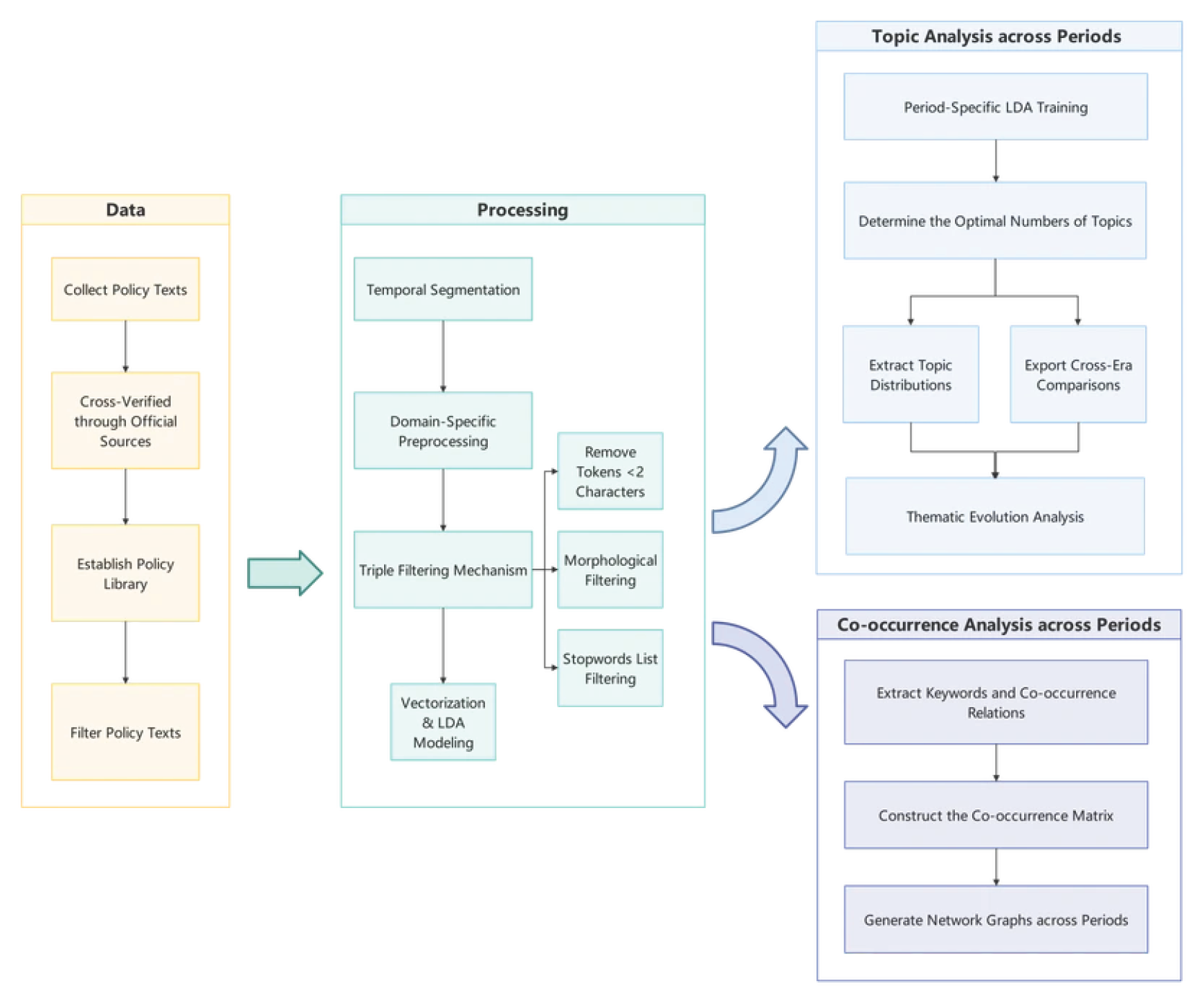
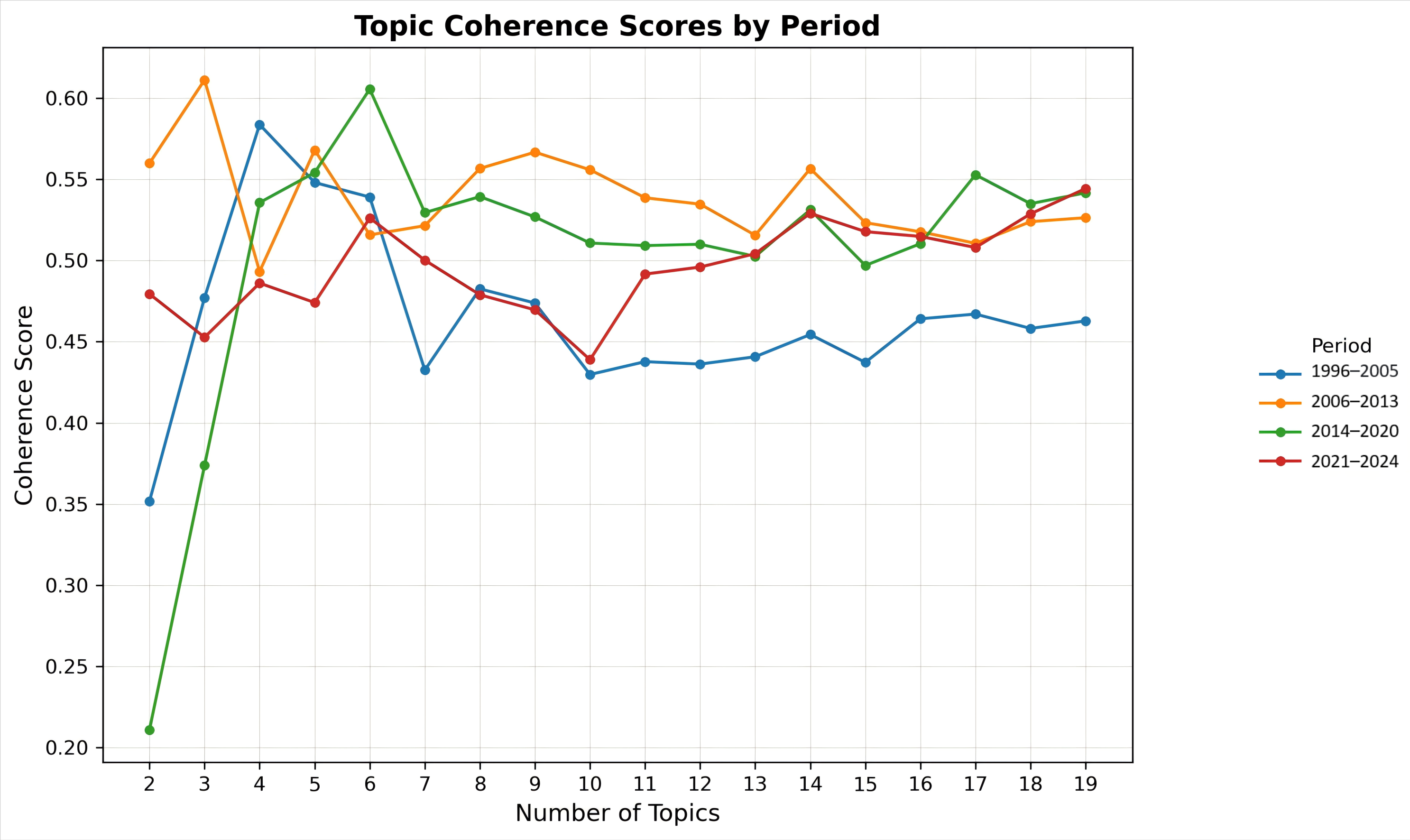
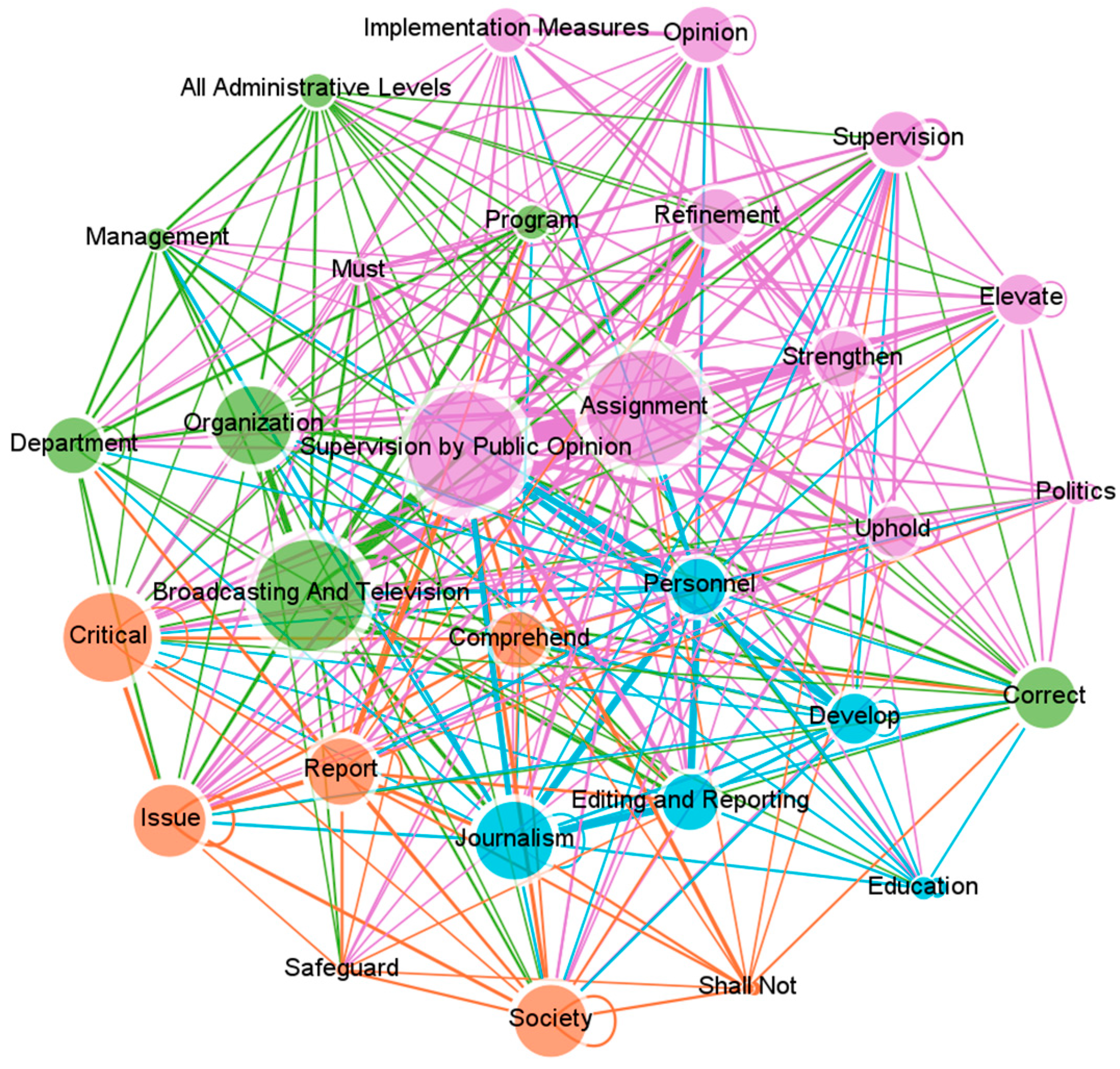
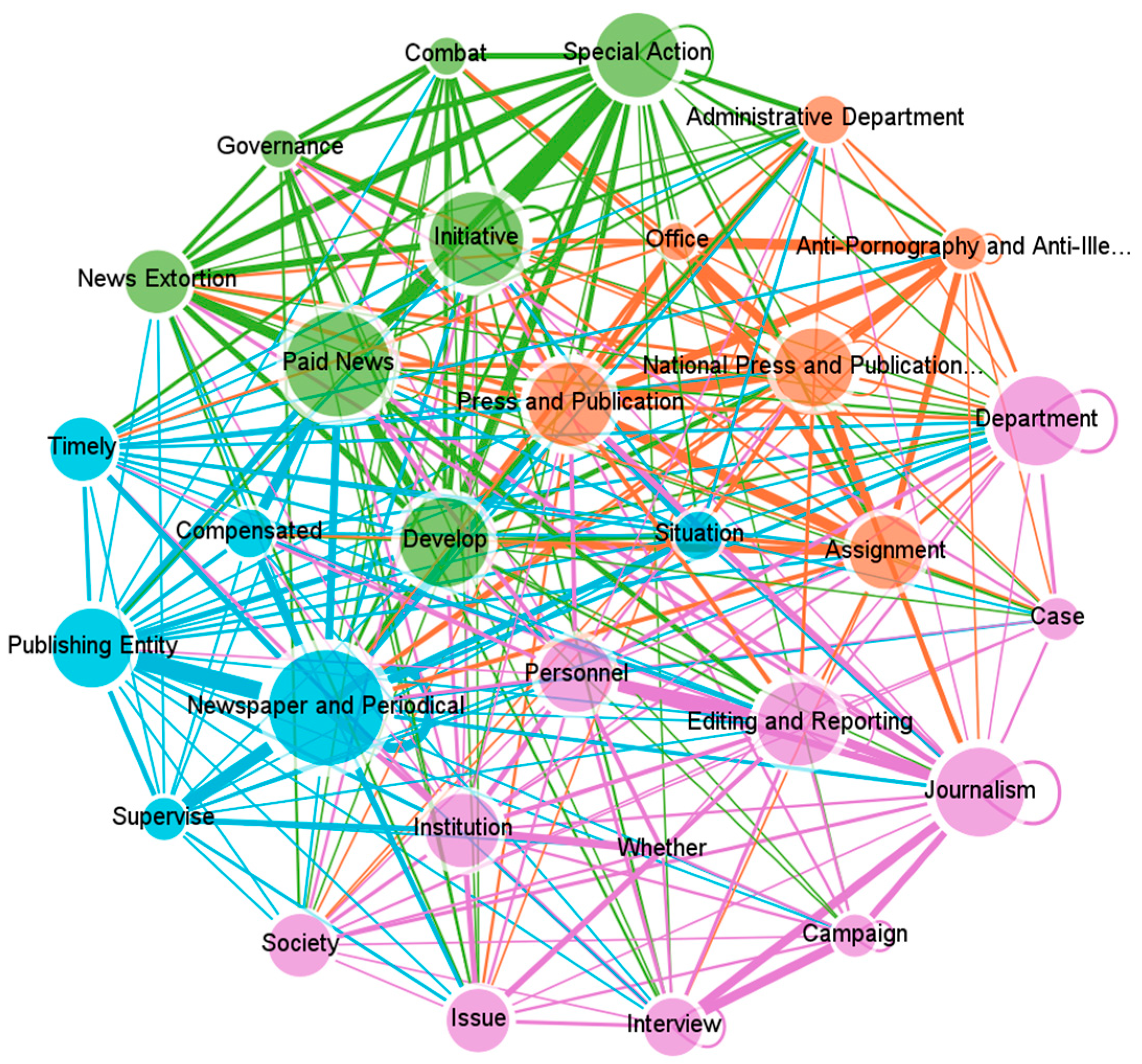
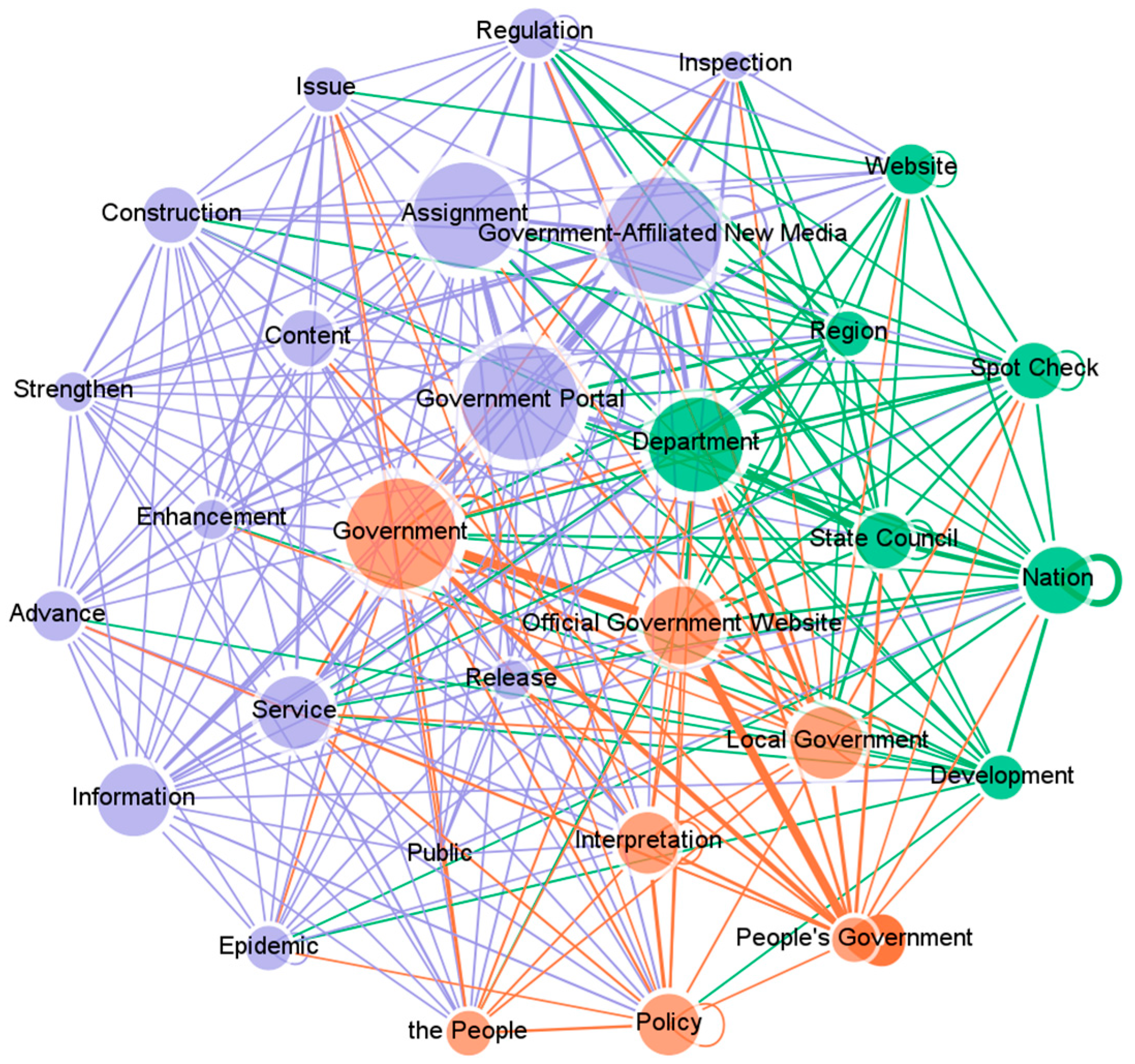

| Topic | Top 10 Relevant Words | Total Share (%) | |
|---|---|---|---|
| 1 | Hierarchical Licensing of Media Institutions | Journalism, Information, Institution, Service, Provision, Online News, Shall, State Council Information Office, Autonomous Region, Establishment | 28.3% |
| 2 | Bureaucratization of Journalism Credentialing Systems | Journalism, Journalist Accreditation Certificate, Organization, Press and Publication, Editing and Reporting, National Press and Publication Administration (NPPA), Personnel, Review, Utilization, Interview | 24.6% |
| 3 | Administrative Governance of Print Media Distribution | Newspaper and Periodical, Governance, Assignment, Central Authorities, Distribution, Department, Issue, Party and Government Departments, Discontinuation, Compulsory Quota Allocation | 20.7% |
| 4 | Civic Oversight Institutionalization in News Systems | Supervision by Public Opinion, Assignment, Journalism, Shall Not, Strengthen, Broadcasting and Television, Uphold, Society, Report, Issue | 16.3% |
| Topic | Top 10 Relevant Words | Total Share (%) | |
|---|---|---|---|
| 1 | Professionalization of Journalistic Practices | Journalism, Journalist Accreditation Certificate, Organization, Press and Publication, Interview, Personnel, Administrative Department, Campaign, Administrative Measures, Editing and Reporting | 23.6% |
| 2 | Construction of Market-Oriented Regulatory System | Press and Publication, Development, Publish, Industry, Publications, Construction, Enterprise, Publishing Industry, Journalism, Market | 15.0% |
| 3 | Ethical Compliance Enforcement | Journalism, Press and Publication, Paid News, Interview, Newspaper and Periodical, Assignment, Develop, Initiative, Personnel, Campaign | 12.7% |
| Topic | Top 10 Relevant Words | Total Share (%) | |
|---|---|---|---|
| 1 | Localized Algorithmic Governance in Media Regulatory Implementation | Local Government, Organization, Journalism, Institution, Competent Authority, Press and Publication, Radio and Television, Administrative Measures, Shall, Editing and Reporting | 31.30% |
| 2 | Comprehensive Governance of Information Ecology | Information, Service, Online News, Internet, Shall, Provision, Security, Service Provider, Nation, Assessment | 29.90% |
| 3 | Techno-Legal Reconfiguration of Sectors | Press and Publication, Broadcasting, Film and Television, Copyright, Rule of Law, Assignment, Legislation, Improvement, Administrative, Law Enforcement | 20.50% |
| 4 | Centralized Professional Coordination Framework for Media Convergence Governance | National Radio and Television Administration (NRTA), Expert, Broadcasting and Television, Development, Media Convergence, Nation, Recommendation, Sector, Expert Database, Institution | 17.50% |
| 5 | Data-Oriented Public Service Delivery | Government Portal, Department, Indicator, Government-Affiliated New Media, Government, Website, Region, People’s Government, Service, Discovery | 15.40% |
| 6 | Content Innovation and Dissemination in Government-Affiliated New Media | Publish, Development, Government-Affiliated New Media, Integration, Content, Assignment, Strengthen, Promote, Dissemination, Technology | 14.10% |
| Topic | Top 10 Relevant Words | Total Share (%) | |
|---|---|---|---|
| 1 | Algorithmic Accountability Frameworks for Self-Media Ecosystems | Self-Media, Platform, Website, Information, Shall, Account, Release, Shall Not, Management, Profit-Making | 19.8% |
| 2 | Dynamic Risk Prevention in Cross-Platform Information Ecology | Information, Web Traffic, Self-Media, Baseline, Platform, Account, Handling, Incident, Release, Hotspot | 13.8% |
| 3 | Content Innovation in Mainstream Media | Broadcasting and Television, Cyberspace, Development, Construction, Audio-Visual, Dissemination, Promote, Program, Innovation, Advance | 13.3% |
| 4 | Differentiated Regulation in Smart Audiovisual Industrial Clusters | Audio-Visual, Cyberspace, Broadcasting and Television, Development, Industry, Strengthen, Dissemination, Construction, Promote, Technology | 12.2% |
| 5 | Intelligent Public Service Platform Convergence | Self-Media, Industrial Corridor, Personnel, Reciprocal Broadcasting, Internet Plus Government Services Platform, Communication Platform, Competent Authority, Personnel System, Humanities, Talent Project | 0.6% |
| 6 | New Infrastructure Engineering for Intelligent Media Convergence | Development, Broadcasting and Television, Construction, Audio-Visual, Cyberspace, Advance, Promote, Dissemination, Program, Innovation | 0.6% |
| Dimensions | 1996–2005 | 2006–2013 | 2014–2020 | 2021–2024 |
|---|---|---|---|---|
| Technological Drivers | 1. Infrastructure Building: Online News, Establishment, Broadcasting and Television; 2. Distribution Channel: Utilization, Distribution; 3. Development of Internet News: Online News, Journalism | 1. Platform development: Development, Publish, Construction; 2. Digital Transformation of Traditional Media: Press and Publication, Editing and Reporting, Publications, Newspaper and Periodical; 3. Development of the Internet: Development, Publish, Industry | 1. Media Convergence: Media Convergence, Integration, Technology, Online News, Internet, Broadcasting and Television, Radio and Television, Film and Television; 2. Digital Empowerment for Refined Governance: Government Portal, Government-Affiliated New Media, Website, Development, Service Provider, Discovery, Publish; 3. Transformation of Content and Communication Systems: Content, Dissemination, Promote, Broadcasting, Radio and Television, Film and Television | 1. Internet Plus Government Services Platform: Platform, Internet Plus Government Services Platform, Communication Platform, Account, Website; 2. Deepening Governance through Digital Technology: Technology, Dissemination, Audio-Visual, Reciprocal Broadcasting, Web Traffic, Baseline, Management, Release; 3. Mature and Rich Media Ecosystem: Self-Media, Platform, Account, Industry, Innovation, Cyberspace |
| Societal Demands | 1. Information Service: Information, Service, Provision; 2. Journalistic Professional Norms: Journalism, Journalist Accreditation Certificate, Interview, Report; 3. Public Opinion Supervision: Supervision by Public Opinion, Society, Report, Issue | 1. Combating News Corruption: Paid News, Journalism, Market; 2. Journalism Professionals: Journalism, Journalist Accreditation Certificate, Personnel, Interview; 3. Institutional Framework of Public Services: Press and Publication, Initiative, Enterprise, Publishing Industry, Administrative Department | 1. Accessibility of Public Services: Information, Provision, Service Provider, Discovery, Internet, Security; 2. Copyright Protection: Copyright, Rule of Law, Legislation, Law Enforcement; 3. Expansion of Channels for Citizens’ Participation in Governance: Information, Service, Internet, People’s Government | 1. Interaction between the Government and the Public: Information, Release, Account, Hotspot, Humanities; 2. People’s Co-Governance: Handling, Incident, Management, Advance; 3. Industrial Development and Economic Benefits: Profit-Making, Industry, Talent Project, Development, Construction, Promote, Program, Industrial Corridor |
| Governance Philosophy | 1. Centralization and Vertical Management: Central Authorities, Department, Party and Government Departments, State Council Information Office; 2. Institutionalized and Professionalized Governance: Institution, Establishment, Journalist Accreditation Certificate, Personnel, Review, Shall, Shall Not; 3. Administrative Integration and Resource Regulation: Organization, Assignment, Discontinuation, Compulsory Quota Allocation, National Press and Publication Administration, Press and Publication, Autonomous Region, Newspaper and Periodical | 1. Administrative-led Organizational Regulation: Administrative Department, Assignment, Administrative Measures; 2. Personnel System and Professional Norms: Journalism, Journalist Accreditation Certificate, Personnel, Interview, Campaign; 3. Ideological Consolidation: Campaign, Journalist Accreditation Certificate, Editing and Reporting, Construction | 1. Institutionalized and Legalized Governance: Institution, Administrative Measures, Legislation, Assessment, Improvement, Rule of Law, Shall, Competent Authority, Law Enforcement; 2. Hierarchical Collaboration and Centralized Coordination: Local Government, Region, Nation, Department, Indicator, Assignment, Government, Organization; 3. Building Professional Governance Capacity: Expert, Expert Database, Development, Recommendation, Sector, Promote, Strengthen | 1. Governance with Human Warmth: Account, Release, Humanities, Management, Hotspot; 2. Industrial Innovation and Promotion: Innovation, Promote, Program, Construction, Cyberspace, Broadcasting and Television, Audio-Visual, Dissemination, Industrial Corridor; 3. Innovation in Grassroots Governance: Communication Platform, Competent Authority, Self-Media, Innovation, Baseline |
Disclaimer/Publisher’s Note: The statements, opinions and data contained in all publications are solely those of the individual author(s) and contributor(s) and not of MDPI and/or the editor(s). MDPI and/or the editor(s) disclaim responsibility for any injury to people or property resulting from any ideas, methods, instructions or products referred to in the content. |
© 2025 by the authors. Licensee MDPI, Basel, Switzerland. This article is an open access article distributed under the terms and conditions of the Creative Commons Attribution (CC BY) license (https://creativecommons.org/licenses/by/4.0/).
Share and Cite
Shao, L.; Ao, M. Thematic Evolution of China’s Media Governance Policies: A Tri-Logic Synergistic Perspective. Information 2025, 16, 696. https://doi.org/10.3390/info16080696
Shao L, Ao M. Thematic Evolution of China’s Media Governance Policies: A Tri-Logic Synergistic Perspective. Information. 2025; 16(8):696. https://doi.org/10.3390/info16080696
Chicago/Turabian StyleShao, Li, and Miao Ao. 2025. "Thematic Evolution of China’s Media Governance Policies: A Tri-Logic Synergistic Perspective" Information 16, no. 8: 696. https://doi.org/10.3390/info16080696
APA StyleShao, L., & Ao, M. (2025). Thematic Evolution of China’s Media Governance Policies: A Tri-Logic Synergistic Perspective. Information, 16(8), 696. https://doi.org/10.3390/info16080696







